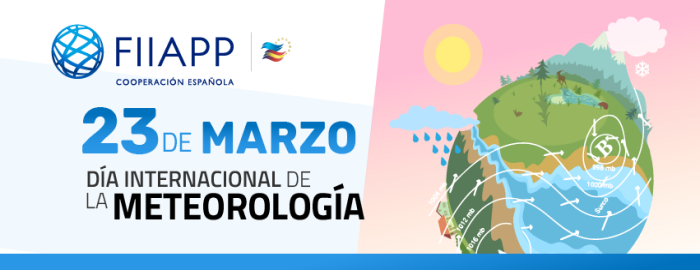-
26 March 2020
Category : Reportage
Cyclogenesis was called climate change
We commemorate World Meteorological Day, which is held on 23 March and which highlights the relationship between meteorology and climate change and the work of EUROCLIMA+ in this regard

Torrential rain and droughts are water-related meteorological phenomena, all increasingly extreme anywhere on the planet. This year, World Meteorological Day, under the heading of “climate and water”, is dedicated to these and other similar phenomena and focuses on the climate change effects which manifest themselves through water.
According to data from the World Meteorological Organisation (WMO), humans cannot survive more than three days without water and there are currently 3 billion people worldwide who do not have basic facilities to wash their hands. Furthermore, knowing this, it must be taken into account that in the next 30 years the world demand for fresh water will increase between 20% and 30%.
With the aim of commemorating the creation of the WMO on 23 March 1950 within the UN, this day also serves to highlight the contribution made by National Meteorological and Hydrological Services (NMHSs) to the security and well-being of societies; and, why not, to reflect on the importance of meteorology in the global context of climate change in which we live today.
Water, a shared asset
Extreme meteorological phenomena, the result of the climate change we all experiencing worldwide, are one of the greatest global threats. Specifically, those related to water pose a major risk due to their impacts both on sustainable development and on people’s safety. According to the WMO Secretary General, Petteri Taalas, in the organisation’s statement about 23 March, “The changes in the global distribution of rainfall are having important repercussions in many countries. Sea levels are rising at an ever-increasing rate due to the melting of larger glaciers, such as those in Greenland and Antarctica. This is exposing coastal areas and islands to an increased risk of flooding and the submergence of low-lying areas.”
Rising rivers or floods are a source of peace and conflict, as most rivers and other freshwater areas cross borders, and decisions made by one country regarding the management of water resources often have an impact on other countries. In addition, food security is closely related to water: for example, the concentration of rainfall at certain times of the year or in certain places affects agriculture, movements and, ultimately, the survival of millions of people all around the world.
Ample evidence of the chosen heading’s international significance is to be found in the fact that water and climate are the cornerstones of Sustainable Development Goal 6 (Clean water and sanitation) and 13 (Climate action), both included in the 2030 Agenda for sustainable development, which contain the global priorities for the next 10 years.
Every drop counts for the EUROCLIMA+ project
As expressly detailed by the WMO, data on water resources are currently incomplete and scattered, which greatly hinders joint work between countries and international cooperation to face global challenges, such as climate change.
The EUROCLIMA+ project is working along these lines, hand in hand with AEMET in Central America, where, together with the different countries’ institutions, they are generating climate scenarios to anticipate the impacts of climate change and plan adaptation measures. In this sense, the project, financed by the EU and with the FIIAPP participating in the management, has its sights set on reviewing the impact, vulnerability and needs of adapting to climate change.
The usefulness of the scenarios, in the words of the project specialist and AEMET meteorologist Jorge Tamayo, depends on having information so as to know “what is going to happen and what measures can be applied”, and also that such information can “be used by those responsible for water management, for planning”, for example “if they have to make a greater number of reservoirs or have to resize those that they currently have, to try to mitigate these effects at least by knowing them.”
Working together to adapt or mitigate climate change is the same as working together for a more resilient future, as EUROCLIMA+ demonstrates.
The views and opinions expressed in this blog are the sole responsibility of the person who write them.




